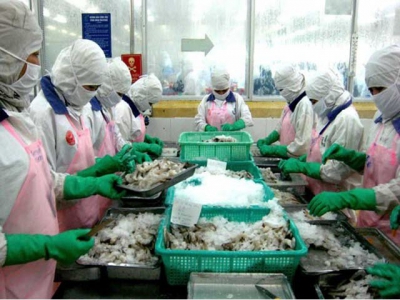Domestic seafood sales hindered by administrative procedures

Ho Chi Minh City – Local seafood enterprises find it difficult to supply their products to the domestic market due to obstacles in administrative procedures, though their products have been accepted by selective markets around the world, reported Nguoi Lao Dong newspaper.
Workers are seen processing shrimp. Local seafood enterprises find it difficult to supply their products to the domestic market due to red tape - PHOTO: TRUNG CHANH
Truong Dinh Hoe, general secretary of the Association of Seafood Exporters and Producers (VASEP), noted that Vietnam has just issued the maximum residue limits (MRLs) of chemicals and antibiotics permissible in seafood farming but has yet to issue regulations on the minimum required performance limits (MRPLs) of substances banned in seafood farming and processing. Therefore, supermarkets do not accept food products with chemical and antibiotic residue even though the residue is negligible and does not affect consumers’ health, and is accepted by the European Union.
A representative of an enterprise supplying seafood locally and abroad said the local market does not accept seafood batches with chloramphenicol, a banned substance in seafood processing and trading, while selective markets such as Japan, South Korea and the European Union allow chloramphenicol residue of less than 0.3 part per billion. This issue has caused multiple difficulties for local seafood traders attempting to provide their products to the domestic market.
The representative suggested Vietnam should update its requirements to match international standards to avoid lagging behind.
Seafood suppliers want the administrative obstacles removed as they are negotiating with supermarkets to supply their products during the Tet holiday.
According to VASEP, the association has reported the problem to the competent agencies for more than a year, but solutions to the problem have yet to be found.
Late last year, VASEP proposed the National Agro-Forestry-Fisheries Quality Assurance Department (Nafiqad) under the Ministry of Agriculture and Rural Development take steps to deal with the problem. However, the department asked the association to direct the problem to the Ministry of Health.
In January, VASEP wrote to the Ministry of Health to report the problem. A month later, the Food Safety Agency under the Ministry of Health ordered VASEP to make suggestions on the MRL of chloramphenicol for locally consumed seafood based on international regulations and the circumstances of local production units and businesses.
Late last month, VASEP held a meeting with representatives of the Department of Legislation of the Ministry of Health, Nafiqad and the Agro Processing and Market Development Authority of the Ministry of Agriculture and Rural Development to discuss solutions to the problem but their efforts were in vain.
On September 24, Nguyen Thanh Phong, head of the Food Safety Agency, responded to VASEP in writing that the problem involves the MRPL, not the MRL, so the Ministry of Agriculture and Rural Development should assume responsibility for resolving the issue.
Meanwhile, representatives of supermarkets in HCMC, such as Lotte Mart and Saigon Co.op, stated that they have used the prevailing regulations of the Ministry of Health in trading seafood products.
VASEP has also reported the problem to Mai Tien Dung, Minister and Chairman of the Government Office and Chairman of the Advisory Council for Administrative Procedure Reform, detailing the shortcomings of regulations on MPRLs for chemical and antibiotic residue in seafood products for local consumption.
Related news
 Vietnam’s seafood exports to ASEAN expected to reach US$1 billion soon
Vietnam’s seafood exports to ASEAN expected to reach US$1 billion soon With its continuous growth over the past 10 years, ASEAN has become an important market for Vietnamese seafood, and the prospect of US$1 billion worth of yearly
 Oils with high SFA levels may support aqua feed fish oil reduction
Oils with high SFA levels may support aqua feed fish oil reduction Use of lipid sources with high levels of saturated fatty acids may support fish production and omega-3 levels in farmed fish fed diets with no fish oil
 Vietnam sees strong growth in aquatic exports to US
Vietnam sees strong growth in aquatic exports to US Vietnam enjoyed a surge of 46 percent in aquatic products’ export value to the US market in August to 188.7 million USD